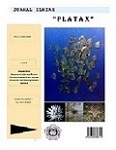The Inventory and Composition Studies of Seagrass in Ratatotok Waters, District of Ratatotok, Southeast Minahasa Regency
DOI:
https://doi.org/10.35800/jip.7.1.2019.22592Abstract
This research was carried out in the coastal waters of Ratatotok Village with the purpose of: 1. Knowing the condition of aquatic environment at research location. 2. Identify seagrass species from Ratatotok waters. 3. To determine the composition of seagrass species which included: Species Density, Relative Density, Abundance, Relative Abundance, Domination, Relative Domination, Frequency, Relative Frequency and Important Values. 7 species from of 2 families were found in this research i.e. Cymodoceaceae (Cymodocea rotundata, Cymodocea serrulata, Syringodium isoetifolium, and Halodule uninervis) and Hydrocharitaceae (Enhalus acoroides, Halophila ovalis and Thalassia hemprichii). The number of seagrass stands in the research were ranged from 26-2699 individuals. Species density were found to range from to 9.51 to 987.06 / m². Relative density were varied from 0.72 to 75.08%. Frequency of occurence were also varied from to 0.69 to 8.46. Relative frequency were ranged from to 2,68-33.04%. Abundance were found to range from to 10.08-1046.88. Relative abundance were varied from 0.72-75.08%. The dominance were range from to 28.89-2998.89 and relative dominance from to 0.72-75.08%. The important value of seagrass in the Ratatotok waters showed that Syringodium isoetifolium had important value reaching to 183.20 %. important values of Cymodocea rotundata and Thalassia hemprichii were 41.93 % and 26.68 % respectively .In addition, these two species were consisted of relatively large individual size compared to other species.
Keywords : Ratatotok, Seagrass, Important Values
ABSTRAK
Penelitian ini dilakukan di Perairan Pantai Desa Ratatotok dengan tujuan untuk: 1. Mengetahui kondisi lingkungan perairan pada lokasi penelitian. 2. Mengidentifikasi spesies lamun di Desa Ratatotok. 3. Mengetahui komposisi spesies lamun yang meliputi: Kepadatan Spesies, Kepadatan Relatif, Kelimpahan, Kelimpahan Relatif, Dominasi, Dominasi Relatif, Frekuensi, Frekuensi Relatif dan Nilai Penting. Spesies lamun yang ditemukan di lokasi penelitian berjumlah 7 spesies dari 2 family: Cymodoceaceae (Cymodocea rotundata, Cymodocea serrulata, Syringodium isoetifolium, dan Halodule uninervis) dan Hydrocharitaceae (Enhalus acoroides, Halophila ovalis dan Thalassia hemprichii). Jumlah tegakan spesies lamun di lokasi penelitian berkisar antara 26-2699 individu, kepadatan spesies 9,51-987,06/m², kepadatan relatif 0,72-75,08 %, frekuensi kehadiran 0,69-8,46, frekuensi relatif 2,68-33,04 %, kelimpahan 10,08-1046,88, kelimpahan relatif 0,72-75,08 %, dominasi 28,89-2998,89 dan dominasi relatif 0,72-75,08 %. Nilai penting lamun di perairan Desa Ratatotok menunjukkan bahwa jenis Syringodium isoetifolium memiliki nilai penting yang mencapai 183,20 %. Untuk jenis Cymodocea rotundata dan jenis Thalassia hemprichii masing-masing memiliki nilai penting yakni 41,93 % dan 26,68 %. Selain itu jumlah indvidu kedua spesies ini banyak ditemui disertai dengan ukuran individu yang relatif besar dibandingkan spesies lainnya.
Kata Kunci : Ratatotok, Lamun, Nilai Penting
Downloads
Published
How to Cite
Issue
Section
License
COPYRIGHT
Authors who publish with this journal agree to the following terms:
Authors hold their copyright and grant this journal the privilege of first publication, with the work simultaneously licensed under a Creative Commons Attribution License that permits others to impart the work with an acknowledgment of the work's origin and initial publication by this journal.
Authors can enter into separate or additional contractual arrangements for the non-exclusive distribution of the journal's published version of the work (for example, post it to an institutional repository or publish it in a book), with an acknowledgment of its underlying publication in this journal.
Authors are permitted and encouraged to post their work online (for example, in institutional repositories or on their website) as it can lead to productive exchanges, as well as earlier and greater citation of the published work (See The Effect of Open Access).




















